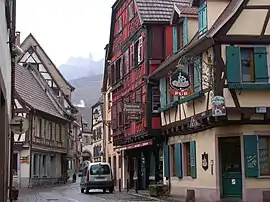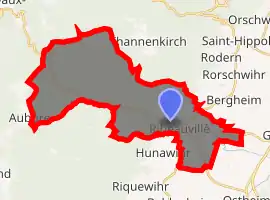Ribeauvillé
Ribeauvillé (French pronunciation: [ʁibovile]; Alsatian: Rappschwihr; German: Rappoltsweiler) is a commune in the Haut-Rhin department in Grand Est in north-eastern France.
Colmar-Ribeauvillé | |
|---|---|
Subprefecture and commune | |
 Ribeauvillé and its castle | |
.svg.png.webp) Coat of arms | |
Location of Colmar-Ribeauvillé 
| |
 Colmar-Ribeauvillé  Colmar-Ribeauvillé | |
| Coordinates: 48°12′N 7°19′E | |
| Country | France |
| Region | Grand Est |
| Department | Haut-Rhin |
| Arrondissement | Colmar-Ribeauvillé |
| Canton | Sainte-Marie-aux-Mines |
| Intercommunality | Ribeauvillé et environs |
| Government | |
| • Mayor (2014–2020) | Jean-Louis Christ |
| Area 1 | 32.21 km2 (12.44 sq mi) |
| Population (2017-01-01)[1] | 4,729 |
| • Density | 150/km2 (380/sq mi) |
| Time zone | UTC+01:00 (CET) |
| • Summer (DST) | UTC+02:00 (CEST) |
| INSEE/Postal code | 68269 /68150 |
| Elevation | 188–989 m (617–3,245 ft) (avg. 240 m or 790 ft) |
| 1 French Land Register data, which excludes lakes, ponds, glaciers > 1 km2 (0.386 sq mi or 247 acres) and river estuaries. | |
Its inhabitants are called Ribeauvillois.
Geography
The town is located around 10 miles (16 km) north of Colmar and 75 kilometres (47 mi)south of Strasbourg. It lies at the foot of the Vosges Mountains.
History
Known in the 8th century as Rathaldovilare, the town passed from the Bishops of Basel to the Lords of Rappoltstein, who were among the most famous nobles in Alsace. The Lord of Rappoltstein was the King or Protector of the wandering minstrels of the land, who purchased his protection by paying him a tax.
When the family became extinct in 1673, this office of "King of the Pipers" (Pfeiferkönig) passed to the Counts Palatine of Zweibrücken-Birkenfeld. The minstrels had a pilgrimage chapel near Rappoltsweiler, dedicated to their patron saint, Maria von Dusenbach, and here they held an annual feast on 8 September. Ribeauvillé was commonly known as Rappoltsweiler until the 19th century.
Sights
Ribeauvillé is in part surrounded by ancient walls, and has many picturesque medieval houses, and two old churches, of St Gregory and St Augustine, both fine Gothic buildings. The town hall contains a valuable collection of antiquities. The Carolabad, a saline spring with a temperature of 64 F. (which held a great reputation in the Middle Ages), was re-discovered in 1888, and made Rappoltsweiler a watering-place.
Near the town are the ruins of three famous castles, Saint-Ulrich, Girsberg and Haut-Ribeaupierre, which formerly belonged to the lords of Ribeaupierre (or Rappoltstein).
The forest of Ribeauvillé is home to the largest giant sequoia outside of the United States.[2]
The former synagogue of the Jewish community is located on the Rue de la Synagogue and is currently used as the town's cinema.
Economy
The economy of Ribeauvillé is mainly based on:
- Tourism, because of its historical heritage and several festivals as, for example Fête des Ménétriers or " Pfifferdaj" (first week-end of September) and Marché de Noël (Christmas);
- Viticulture: Ribeauvillé is located in the middle of the Alsace wineyards and is home to many viticulturists. Most of them are associated in a winemaking co-operative named Cave de Ribeauvillé (established 1895), one of the oldest in France;[3]
- Manufacturing: There is the fabric printing factory Beauvillé and a Cordon Electronics factory located nearby
Notable people
- Philipp Jakob Spener (1635–1705), Lutheran theologian
- Johann Baptist Wendling (1723–1797), flautist and composer
- Jean-Michel Beysser (1753–1794), French general
- Carl August von Steinheil (1801–1870), physicist
- Maurice Lévy (1838–1910), engineer
- Jean-François Klobb (1857–1899), French officer
- Hubert Keller, chef
See also
References
- "Populations légales 2017". INSEE. Retrieved 6 January 2020.
- Giant sequoia in the forêt domaniale de Ribeauvillé
- Cooperative website alsace.vins-ribeauville.com Archived 2013-03-18 at the Wayback Machine
